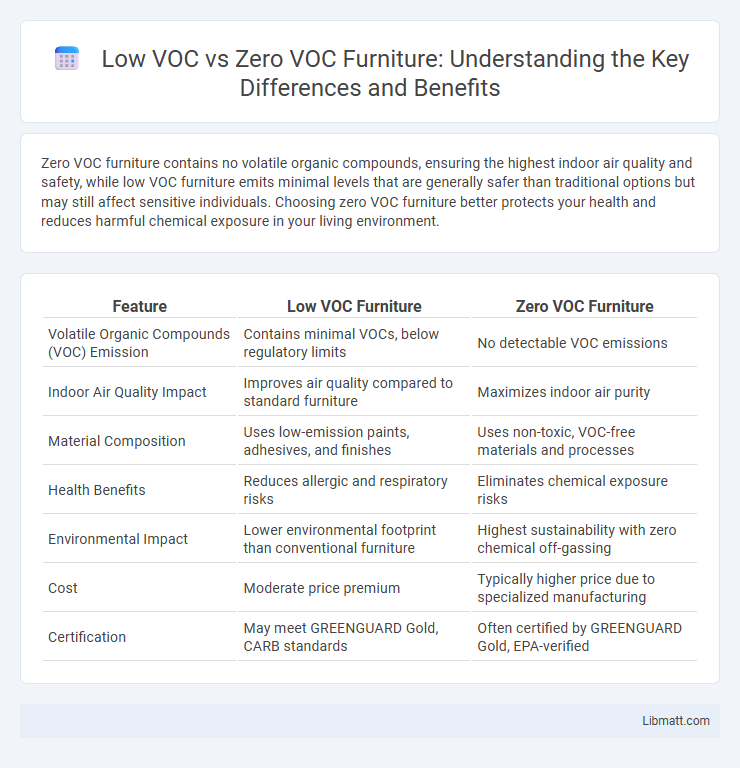Zero VOC furniture contains no volatile organic compounds, ensuring the highest indoor air quality and safety, while low VOC furniture emits minimal levels that are generally safer than traditional options but may still affect sensitive individuals. Choosing zero VOC furniture better protects your health and reduces harmful chemical exposure in your living environment.
Table of Comparison
| Feature | Low VOC Furniture | Zero VOC Furniture |
|---|---|---|
| Volatile Organic Compounds (VOC) Emission | Contains minimal VOCs, below regulatory limits | No detectable VOC emissions |
| Indoor Air Quality Impact | Improves air quality compared to standard furniture | Maximizes indoor air purity |
| Material Composition | Uses low-emission paints, adhesives, and finishes | Uses non-toxic, VOC-free materials and processes |
| Health Benefits | Reduces allergic and respiratory risks | Eliminates chemical exposure risks |
| Environmental Impact | Lower environmental footprint than conventional furniture | Highest sustainability with zero chemical off-gassing |
| Cost | Moderate price premium | Typically higher price due to specialized manufacturing |
| Certification | May meet GREENGUARD Gold, CARB standards | Often certified by GREENGUARD Gold, EPA-verified |
Understanding VOCs in Furniture
Volatile Organic Compounds (VOCs) in furniture refer to chemicals released from materials like paints, adhesives, and finishes, impacting indoor air quality. Low VOC furniture contains reduced levels of these emissions, minimizing health risks such as headaches and respiratory issues. Choosing zero VOC furniture ensures your indoor space is free from harmful chemical off-gassing, promoting a healthier environment for you and your family.
Why VOC Levels Matter in Indoor Air Quality
Low VOC furniture releases fewer volatile organic compounds, reducing indoor air pollution and potential health risks such as headaches, respiratory issues, and allergic reactions. Zero VOC furniture eliminates these emissions almost entirely, promoting a cleaner and safer indoor environment, crucial for individuals with asthma or chemical sensitivities. Maintaining low VOC levels is essential for improving overall indoor air quality and ensuring long-term well-being in residential and commercial spaces.
Defining Low VOC vs Zero VOC Furniture
Low VOC furniture releases minimal volatile organic compounds, typically below a specified threshold, reducing harmful indoor air pollutants compared to standard furniture. Zero VOC furniture is formulated to emit no VOCs or only trace amounts, aiming for the highest indoor air quality and safety standards. Choosing your furniture based on VOC levels helps create a healthier living environment by minimizing exposure to toxic chemicals.
Health Impacts of VOC Emissions
Low VOC furniture releases fewer volatile organic compounds, reducing toxic indoor air pollutants that can cause headaches, respiratory issues, and allergic reactions. Zero VOC furniture eliminates these emissions almost entirely, offering a healthier living environment by minimizing your exposure to harmful chemicals. Selecting zero VOC options supports better air quality and long-term well-being for you and your family.
Common Sources of VOCs in Furniture
Common sources of VOCs in furniture include adhesives, finishes, and upholstery materials that emit formaldehyde, benzene, and toluene. Low VOC furniture contains reduced levels of these compounds, limiting off-gassing from resins, glues, and paints compared to traditional furniture. Zero VOC furniture eliminates synthetic chemicals, using natural oils and water-based finishes to minimize indoor air pollution and enhance air quality.
Benefits of Choosing Low VOC Furniture
Low VOC furniture significantly improves indoor air quality by emitting fewer harmful chemicals compared to traditional furniture, reducing health risks such as respiratory issues and allergies. Choosing low VOC options supports environmental sustainability through lower emissions of volatile organic compounds that contribute to air pollution. Your living space becomes safer and more eco-friendly while maintaining affordable and stylish furniture choices that prioritize your well-being.
Advantages of Zero VOC Furniture
Zero VOC furniture significantly improves indoor air quality by emitting negligible harmful chemicals, reducing health risks such as allergies and respiratory issues. Choosing zero VOC materials ensures safer environments for children, pets, and sensitive individuals, promoting overall well-being in your home or office. This furniture type also supports eco-friendly living by minimizing environmental pollution during production and disposal.
Cost Comparison: Low VOC vs Zero VOC
Low VOC furniture generally costs less than zero VOC options due to the inclusion of small amounts of volatile organic compounds that reduce manufacturing expenses. Zero VOC furniture commands a premium price because it requires specialized materials and manufacturing processes to eliminate all harmful emissions. Your investment in zero VOC products supports healthier indoor air quality but typically comes with higher upfront costs compared to low VOC alternatives.
How to Identify VOC Levels in Furniture
Identifying VOC levels in furniture involves checking product labels and certifications such as GREENGUARD or Green Seal, which indicate low or zero VOC emissions. You can also inquire about the materials used, favoring natural wood, low-VOC finishes, and water-based adhesives to reduce indoor air pollution. Your awareness of VOC indicators helps ensure healthier indoor environments by selecting furniture with minimal chemical emissions.
Tips for Choosing Safe, Eco-Friendly Furniture
Choosing safe, eco-friendly furniture involves prioritizing materials with low levels of volatile organic compounds (VOCs) to reduce indoor air pollution and health risks. Opt for certified low VOC or zero VOC products verified by organizations such as GREENGUARD or UL Environment, which ensure emissions meet strict environmental standards. Look for natural, non-toxic finishes like water-based stains and avoid furniture made with formaldehyde-based adhesives or synthetic chemicals for a healthier living space.
Low VOC vs Zero VOC Furniture Infographic

 libmatt.com
libmatt.com